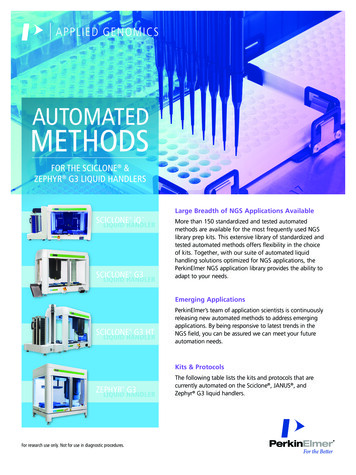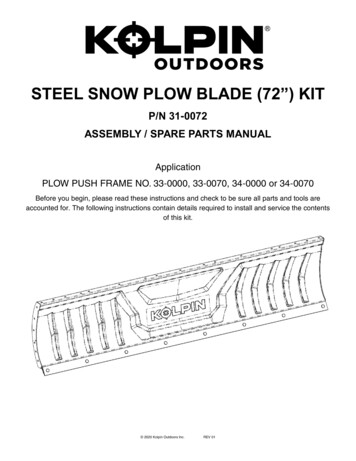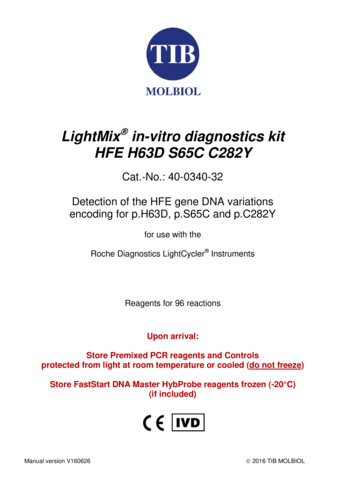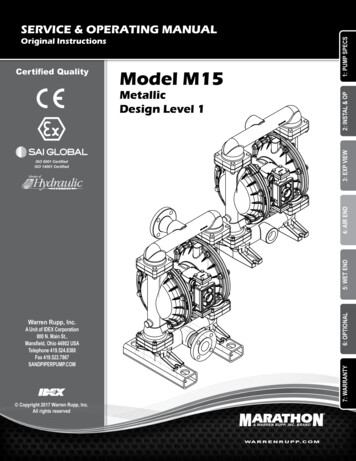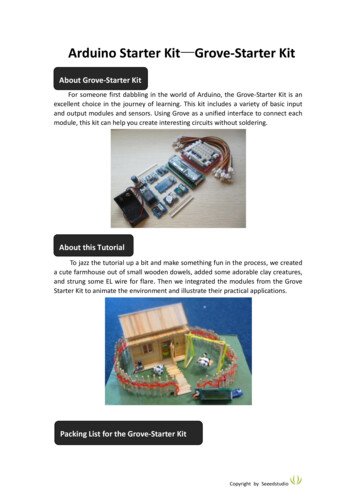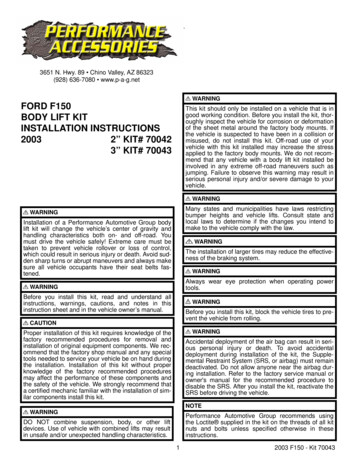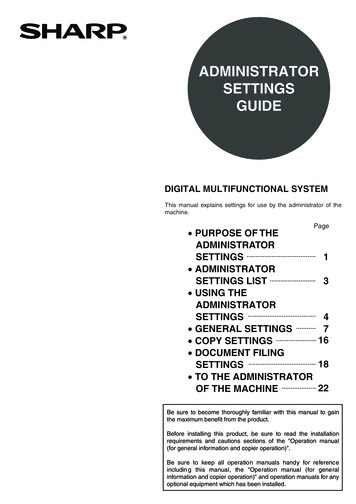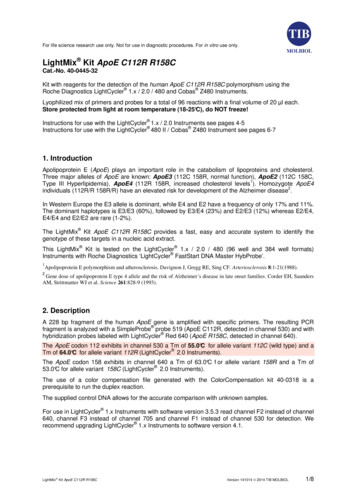
Transcription
For life science research use only. Not for use in diagnostic procedures. For in vitro use only.LightMix Kit ApoE C112R R158CCat.-No. 40-0445-32Kit with reagents for the detection of the human ApoE C112R R158C polymorphism using theRoche Diagnostics LightCycler 1.x / 2.0 / 480 and Cobas Z480 Instruments.Lyophilized mix of primers and probes for a total of 96 reactions with a final volume of 20 µl each.Store protected from light at room temperature (18-25 C), do NOT freeze!Instructions for use with the LightCycler 1.x / 2.0 Instruments see pages 4-5Instructions for use with the LightCycler 480 II / Cobas Z480 Instrument see pages 6-71. IntroductionApolipoprotein E (ApoE) plays an important role in the catabolism of lipoproteins and cholesterol.Three major alleles of ApoE are known: ApoE3 (112C 158R, normal function), ApoE2 (112C 158C,Type III Hyperlipidemia), ApoE4 (112R 158R, increased cholesterol levels1). Homozygote ApoE4individuals (112R/R 158R/R) have an elevated risk for development of the Alzheimer disease2.In Western Europe the E3 allele is dominant, while E4 and E2 have a frequency of only 17% and 11%.The dominant haplotypes is E3/E3 (60%), followed by E3/E4 (23%) and E2/E3 (12%) whereas E2/E4,E4/E4 and E2/E2 are rare (1-2%).The LightMix Kit ApoE C112R R158C provides a fast, easy and accurate system to identify thegenotype of these targets in a nucleic acid extract.This LightMix Kit is tested on the LightCycler 1.x / 2.0 / 480 (96 well and 384 well formats)Instruments with Roche Diagnostics ‘LightCycler FastStart DNA Master HybProbe’.1Apolipoprotein E polymorphism and atherosclerosis. Davignon J, Gregg RE, Sing CF. Arteriosclerosis 8:1-21(1988).2Gene dose of apolipoprotein E type 4 allele and the risk of Alzheimer s disease in late onset families. Corder EH, SaundersAM, Strittmatter WJ et al. Science 261:828-9 (1993).2. DescriptionA 228 bp fragment of the human ApoE gene is amplified with specific primers. The resulting PCRfragment is analyzed with a SimpleProbe probe 519 (ApoE C112R, detected in channel 530) and withhybridization probes labeled with LightCycler Red 640 (ApoE R158C, detected in channel 640).The ApoE codon 112 exhibits in channel 530 a Tm of 55.0 C for allele variant 112C (wild type) and aTm of 64.0 C for allele variant 112R (LightCycler 2.0 Instruments).The ApoE codon 158 exhibits in channel 640 a Tm of 63.0 C f or allele variant 158R and a Tm of53.0 C for allele variant 158C (LightCycler 2.0 Instruments).The use of a color compensation file generated with the ColorCompensation kit 40-0318 is aprerequisite to run the duplex reaction.The supplied control DNA allows for the accurate comparison with unknown samples.For use in LightCycler 1.x Instruments with software version 3.5.3 read channel F2 instead of channel640, channel F3 instead of channel 705 and channel F1 instead of channel 530 for detection. Werecommend upgrading LightCycler 1.x Instruments to software version 4.1.LightMix Kit ApoE C112R R158CVersion 141014 2014 TIB MOLBIOL1/8
3. Set contents3Vials with red caps containing lyophilized primers and probes for each 32 PCR reactions ApoE1Vial with colorless cap with control DNA (ApoE 112C/C 158C/C), 105 target equivalents per rxn1Vial with colorless cap with control DNA (ApoE 112R/R 158R/R), 105 target equivalents per rxn1Vial with colorless cap with control DNA (ApoE 112C/R 158R/C), 105 target equivalents per rxn1Vial with white cap containing DMSO.Note: The vial contains some brown spheres of molecular sieveto keep the DMSO free of water.4. Additional reagents and items requiredTIB MOLBIOL:ColorCompensation HybProbe 40-0318-00Cat.-No. 05 997 704 001Roche Diagnostics:LightCycler FastStart DNA Master HybProbeCat.-No. 03 003 248 001High Pure PCR Template Preparation KitLightCycler Capillaries (20 µl) (LightCycler 1.x / 2.0 Instruments only)LightCycler 480 Multiwell Plate 384, white (LightCycler 480 Systems only)LightCycler 480 Multiwell Plate 96, white (LightCycler 480 Systems only)Cat.-No. 11 796 828 001Cat.-No. 04 929 292 001Cat.-No. 04 729 749 001Cat.-No. 04 729 692 0015. Product characteristicsPCR results are obtained within 45 minutes (45 cycles and melting curve) with the LightCycler 1.x / 2.0Instruments and within 75 minutes (45 cycles and melting curve) with the LightCycler 480 Instrument.SensitivityThese reagents detect 1 ng of human genomic DNA using the Roche ‘LightCycler FastStart DNAMaster HybProbe’ with the LightCycler 1.x / 2.0 / 480 Instruments.Measuring rangeThe measuring range of the assay is 1 ng to 100 ng of human genomic DNA using the Roche‘LightCycler FastStart DNA Master HybProbe’ with the LightCycler 1.x / 2.0 / 480 Instruments.Storage and Stability Lyophilized reagents are stable for at least 6 months after shipment if stored protected from lightat room temperature (18-25 C). See expiry date o n the product label. Do not freeze lyophilized reagents. Dissolved reagents are stable for at least 10 days when stored protected from light and refrigerated (4 C).LightMix Kit ApoE C112R R158CVersion 141014 2014 TIB MOLBIOL2/8
6. Experimental ProtocolThe following procedure was developed for use with the LightCycler 1.x / 2.0 / 480 Instruments.Start programming before preparing the solutions. See the Instrument operator’s manual for details.Sample material: Use aqueous nucleic acid preparations (e.g. ‘High Pure PCR Template Preparation Kit’).Negative control: Always run at least one no-template control (NTC) - replace the template DNA with water.Positive control: Run a positive control - replace the template DNA with the provided control DNA.6.1. Preparation of parameter-specific reagents (32 reactions):One reagent vial with a red cap contains all primers and probes to run 32 reactions ApoE.Add 66 µl PCR-grade water to each reagent vial, mix the solution (vortex) and spin down. Use 2 µl reagent for a 20 µl PCR reaction.This solution is stable at least five days when stored refrigerated at 4 C. Avoid prolonged exposure t o light.6.2. Preparation of the control DNAAdd 80 µl PCR-grade water to each vial (16 x 105 target molecules) with a colorless cap. Mix targetDNA by pipetting the solution up and down 10 times (final concentration: 105 target molecules in 5 µl).Note: Control DNA can be dissolved up to 160 µl to achieve 32 control reactions. Use 5 µl control DNA for a 20 µl PCR reaction.This solution is stable at least five days when stored refrigerated at 4 C, for long term storage free ze at -20 C. Avoid repeatedfreezing thawing cycles. For the heterozygote control DNA provided with the kit please note that the relative amounts of wildtype DNA and mutant DNA may change during time.Please note that opening these vials may cause contaminations of the work-space (aerosol).6.3. Preparation of the LightCycler reaction mixIn a cooled reaction tube, prepare the reaction mix by multiplying each volume for a single reaction bythe number of reactions to be cycled plus one additional reaction.For use with the Roche FastStart MasterSinglereactionComponent8.2 µlwater, PCR-grade (colorless cap, provided with the Roche Master kit)1.6 µlMg solution 25 mM (blue cap, provided with the Roche FastStart kit)2.0 µlreagent mix (parameter specific reagents containing primers and probes, see 6.1.)1.2 µlDMSO (vial contains molecular sieve - pipett the colorless liquid only)2.0 µlRoche Master (red cap, for preparation see Roche manual)15.0 µl2 Volume of reaction mixMix gently, spin down and transfer 15 µl each of the reaction mix to a LightCycler capillary(LightCycler 1.x / 2.0 Instrument) or to a multiwell plate (LightCycler 480 Instrument).Add 5 µl of sample or control DNA to each capillary or well for a final reaction volume of 20 µl.Start run.LightMix Kit ApoE C112R R158CVersion 141014 2014 TIB MOLBIOL3/8
7. LightCycler 1.x / 2.0 Instruments7.1. ProgrammingThe protocol consists of four program steps 1: Denaturation: sample denaturation and enzyme activation 2: Cycling: PCR-amplification of the target DNA 3: Melting: melting curve analysis for identification of the PCR product derived from the target DNA 4: Cooling: cooling the instrumentProgram Step: ysis ModeNoneQuantification modeMelting Curves modeCycles1451Target [ C]9595607200:00:05 00:00:10 00:00:1519540854000:00:30Hold [hh:mm:ss]00:10:0000:00:2000:00:2000:00:00Ramp Rate [ C/s]2020202020200.220Acquisition ModeNoneNoneSingleNoneNoneNoneContinuousNone7.2. Data AnalysisFor use in LightCycler 1.x Instruments use channel F2 instead of channel 640 and channel F1instead of channel 530 for detection.Switch the color compensation mode on. If this mode is not enabled run the color compensationprogram. Follow the instructions in the manual of the TIB MOLBIOL Color Compensation HybProbe.Perform data analysis, as described in the LightCycler Instrument operator’s manual.We recommend using the Second Derivative Maximum method (Automated (F'' max)). The cyclenumber of the Crossing Point (CP) of each sample is calculated automatically. The Fit Points methodis more-error prone due to the user's influence.View ApoE C112R data in channel 530 and ApoE R158C data in channel 640, “Tm Calling” Analysismode (LightCycler 2.0 Instrument) or Melting Curves mode (LightCycler 1.x Instrument). Thenegative control (NTC) must show no signal.LightMix Kit ApoE C112R R158CVersion 141014 2014 TIB MOLBIOL4/8
7.3. Sample Data – Typical Results LightCycler2.0 InstrumentRoche Master:Fast StartSample dataforApoE C112RChannel 530 LightCycler2.0 InstrumentRoche Master:Fast StartSample dataforApoE R158CChannel 640Fig.1. Sample data for the ApoE C112R R158C detection system. Upper panels: Data from LightCycler 2.0 Instrument. Left panel channel 530 melting curves for ApoE C112R. Right panelchannel 530 melting peaks for ApoE C112R. Wildtype (wt) corresponds with ApoE 112C/C, heterozygote corresponds withApoE 112C/R and mutant (mt) corresponds with ApoE 112R/R. Lower panels: Data from LightCycler 2.0 Instrument. Left panel channel 640 melting curves for ApoE R158C. Right panelchannel 640 melting peaks for ApoE R158C. Wildtype (wt) corresponds with ApoE 158R/R, heterozygote corresponds withApoE 158R/C and mutant (mt) corresponds with ApoE 158C/C.7.4. Interpretation of dataAllele(amino acid)112 C/C158 R/R112 C/C158 C/C112 C/C158 C/R112 C/R158 C/R112 C/R158 R/RApoE TypeE3 / E3E2 / E2E2 / E3E2 / E4E3 / E4Tm of peaks 53055 C55 C55 CTm of peaks 64063 C53 C53 C / 63 CPhenotype / Risknormalwild type55 C / 64 C53 C / 63 C112 R/R158 R/R/RE4 / E455 C / 64 C64 C63 C63 CHigh risk forAlzheimerDiseaseType IIIHyperlipidemiaE4 : Increased Cholesterol rare Tab. 3. Typical analysis results (LightCycler 2.0 Instrument, Roche Master: Fast Start)Notes: The values of the respective melting temperatures (TM) may vary 2.5 C between different experiments. Th e T betweenthe melting peaks for heterozygote genotypes may vary 1.5 C. Samples with deviating melting curves sh ould be subject tofurther investigations; sequence analysis can be provided by TIB MOLBIOL Berlin (contact service@tib-molbiol.de).LightMix Kit ApoE C112R R158CVersion 141014 2014 TIB MOLBIOL5/8
8. LightCycler 480 II / Cobas Z 480 Instruments8.1. ProgrammingThe protocol consists of four program steps 1: Denaturation: sample denaturation and enzyme activation 2: Cycling: PCR-amplification of the target DNA 3: Melting: melting curve analysis for identification of the PCR product derived from the target DNA 4: Cooling: cooling the instrumentDetection Format:LightCycler 480 Instrument: 483-533, 483-640LightCycler 480 II Instrument: 465-510, 498-640Cobas Z480 Instrument:465-510, 498-645Program Step: ysis ModeNoneQuantification modeMelting Curves modeCycles1451Target [ C]95Hold 304.44.42.24.44.41.5-1.5Ramp Rate [ C/s] eContinuousNone------1-Acquisitions [per C]00:00:05 00:00:10 00:00:15195Ramp Rate [ C/s] 96Acquisition Mode00:10:00958.2. Data AnalysisNote: Cobas Z480 Instruments signal levels are about 50% compared to LightCycler 480 II results.Note: Select Filter Combination as listed in the Detection Format table above.Switch the color compensation mode on. If this mode is not enabled run the color compensationprogram. Follow the instructions in the manual of the TIB MOLBIOL Color Compensation HybProbe.Perform data analysis, as described in the LightCycler Instrument operator’s manual.We recommend using the Second Derivative Maximum method (Automated (F'' max)). The cyclenumber of the Crossing Point (CP) of each sample is calculated automatically. The Fit Points methodis more-error prone due to the user's influence.View ApoE C112R data with Filter Combination 483-533 (465-510) and ApoE R158C data with FilterCombination 483-640 (498-640/645), “Tm Calling” Analysis mode.The negative control (NTC) must show no signal.LightMix Kit ApoE C112R R158CVersion 141014 2014 TIB MOLBIOL6/8
8.3. Sample Data – Typical Results LightCycler 480 IIInstrument112Rmt112CwtRoche Master:Fast StartSample dataforApoE C112RFilter Combin.465-51055 C64 C 158CmtLightCycler 480 IIInstrument158RwtRoche Master:Fast StartSample dataforApoE R158CFilter Combin.498-64053 C64 CFig.2. Sample data for the ApoE C112R R158C detection system. Upper panels: Data from LightCycler 480 Instrument. Left panel Filter Combination 465-510 melting curves for ApoE C112R.Right panel Filter Combination 465-510 melting peaks for ApoE C112R. Wildtype (wt) corresponds with ApoE 112C/C,heterozygote corresponds with ApoE 112C/R and mutant (mt) corresponds with ApoE 112R/R. Lower panels: Data from LightCycler 480 Instrument. Left panel Filter Combination 498-640 melting curves for ApoE R158C.Right panel Filter Combination 498-640 melting peaks for ApoE R158C. Wildtype (wt) corresponds with ApoE 158R/R,heterozygote corresponds with ApoE 158R/C and mutant (mt) corresponds with ApoE 158C/C.8.4. Interpretation of DataAllele(amino acid)112 C/C158 R/R112 C/C158 C/C112 C/C158 C/R112 C/R158 C/R112 C/R158 R/R112 R/R158 R/R/RApoE TypeE3 / E3E2 / E2E2 / E3E2 / E4E3 / E4Tm of peaks 53055 C55 C55 C55 C / 64 C55 C / 64 C64 CTm of peaks 64064 C53 C53 C / 64 C53 C / 64 C64 C64 CPhenotype / Risknormalwild typeType IIIHyperlipidemiaE4 / E4High risk forAlzheimerDiseaseE4 : Increased Cholesterol rare Tab. 3. Typical analysis results (LightCycler 480 II Instrument, Roche Master: Fast Start)Notes: The values of the respective melting temperatures (TM) may vary 2.5 C between different experiments. Th e T betweenthe melting peaks for heterozygote genotypes may vary 1.5 C. Samples with deviating melting curves sh ould be subject tofurther investigations; sequence analysis can be provided by TIB MOLBIOL Berlin (contact service@tib-molbiol.de).LightMix Kit ApoE C112R R158CVersion 141014 2014 TIB MOLBIOL7/8
9. Version HistoryModifications requiring changes in procedures are printed red.V110125V110511V111027V120702Double amount of control DNA32rxn per vialAdjustment of melting temperatures for LC 480Users reported low or missing signals in the 530 channel.Change of SimpleProbe sensor probe in order to increasethe signals in channel 530 results in higher melting points.Corrected Tm in interpretation table.MSDS included, editorial changesEditorial changesV120704V130628V14101410. Material Safety DataAccording to OSHA 29CFR1910.1200, Commonwealth of Australia [NOHSC:1005, 1008 (1999)] andthe European Union Directives 67/548/EC and 1999/45/EC any products which not contain more than1% of a component classified as hazardous or classified as carcinogenic do not require a MaterialSafety Data Sheet (MSDS).Product is not hazardous, not toxic, not IATA-restricted. Product is not from human, animal or plantorigin. Product contains synthetic oligonucleotide primers and probes.11. Additional InformationA diagnostic use CE-IVD marked kit version will be available from July 2013 (Cat.-No. 40-0445-64)Roche SAP order n 05997712001Notice to Purchaser4260159331622A license under U.S. Patents 4,683,202, 4,683,195 and 4,965,188 or their foreign counterparts, owned by Hoffmann-La RocheInc. and F. Hoffmann-La Roche Ltd (“Roche”), has an up-front fee component and a running-royalty component. The purchaseprice of this product includes limited, nontransferable rights under the running-royalty component to use only this amount of theproduct to practice the Polymerase Chain Reaction (“PCR”) and related processes described in said patents solely for theresearch and development activities of the purchaser when this product is used in conjunction with a thermal cycler whose useis covered by the up-front fee component. Rights to the up-front fee component must be obtained by the end user in order tohave a complete license. These rights under the upfront fee component may be purchased from Perkin-Elmer or obtained bypurchasing an authorized thermal cycler. No right to perform or offer commercial services of any kind using PCR, includingwithout limitation reporting the results of purchaser's activities for a fee or other commercial consideration, is hereby granted byimplication or estoppel. Further information on purchasing licenses to practice the PCR process for research applications maybe obtained by contacting the Director of Licensing at The Perkin-Elmer Corporation, 850 Lincoln Center Drive, Foster City,California 94404 or at Roche Molecular Systems, Inc., 1145 Atlantic Avenue, Alameda, California 94501. The purchase of thisproduct does not convey any right for its use in clinical diagnostic applications. No rights for TaqMan technology under U.S.Patents 5,210,015 and 5,487,972 are hereby conveyed.These reagents were developed and manufactured by TIB MOLBIOL GmbH, Berlin, Germany. SimpleProbe probes and LightCycler hybridization probes produced under license from Roche Diagnostics GmbH.LightMix Kit ApoE C112R R158CVersion 141014 2014 TIB MOLBIOL8/8
LightCycler FastStart DNA Master HybProbe Cat.-No. 03 003 248 001 High Pure PCR Template Preparation Kit Cat.-No. 11 796 828 001 LightCycler Capillaries (20 µl) (LightCycler 1.x / 2.0 Instruments only) Cat.-No. 04 929 292 001 LightCycler 480 Multiwell Plate 384, white (LightCycler 480 Systems only) Cat.-No. 04 729 749 001



